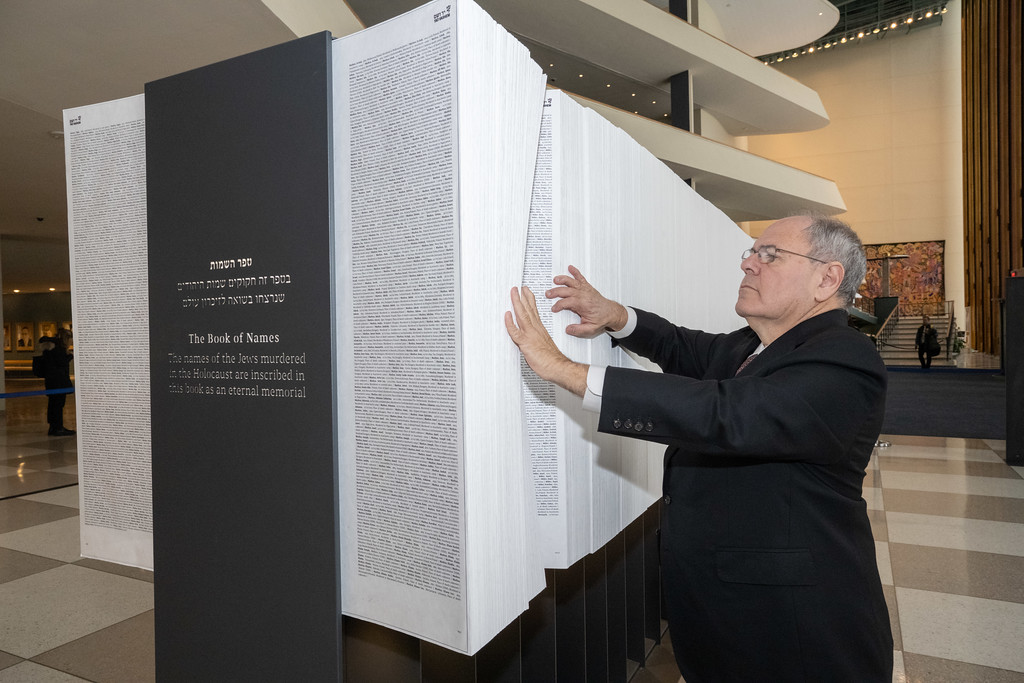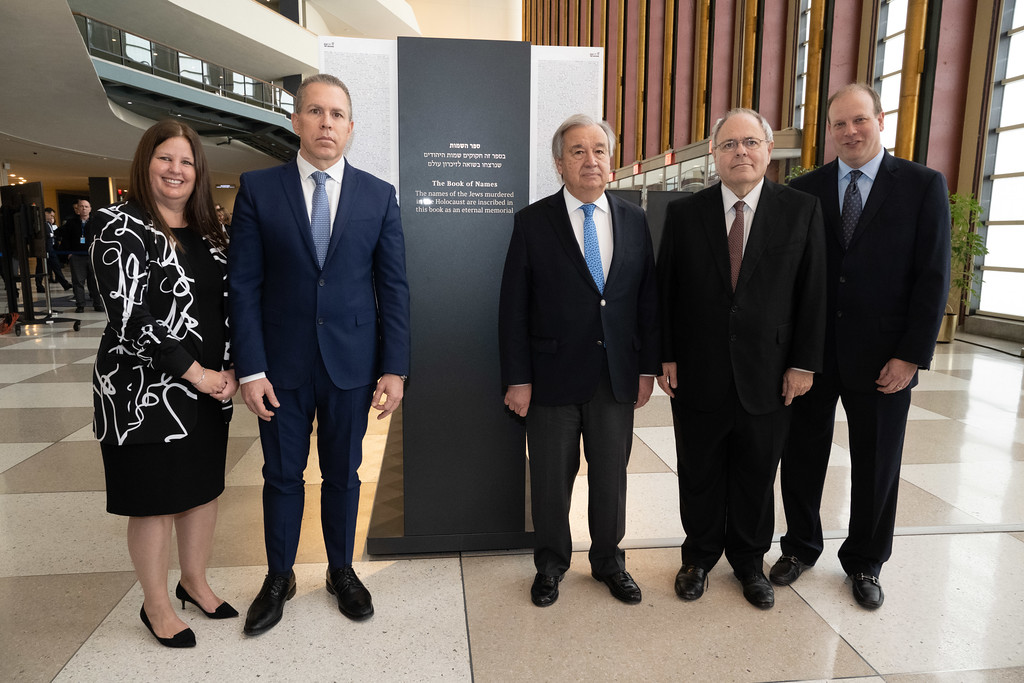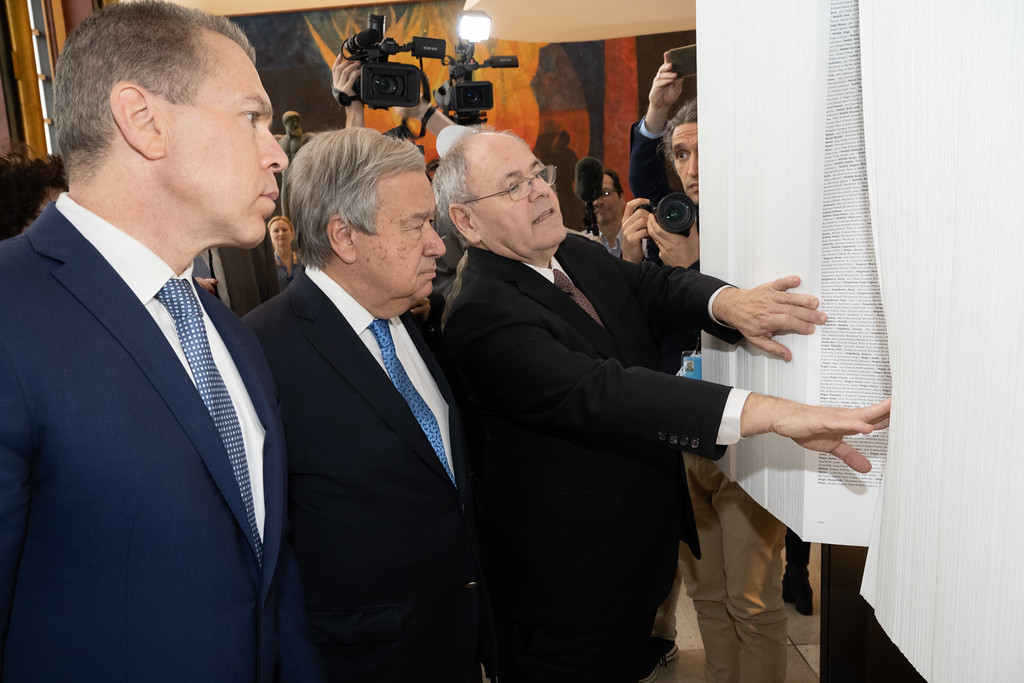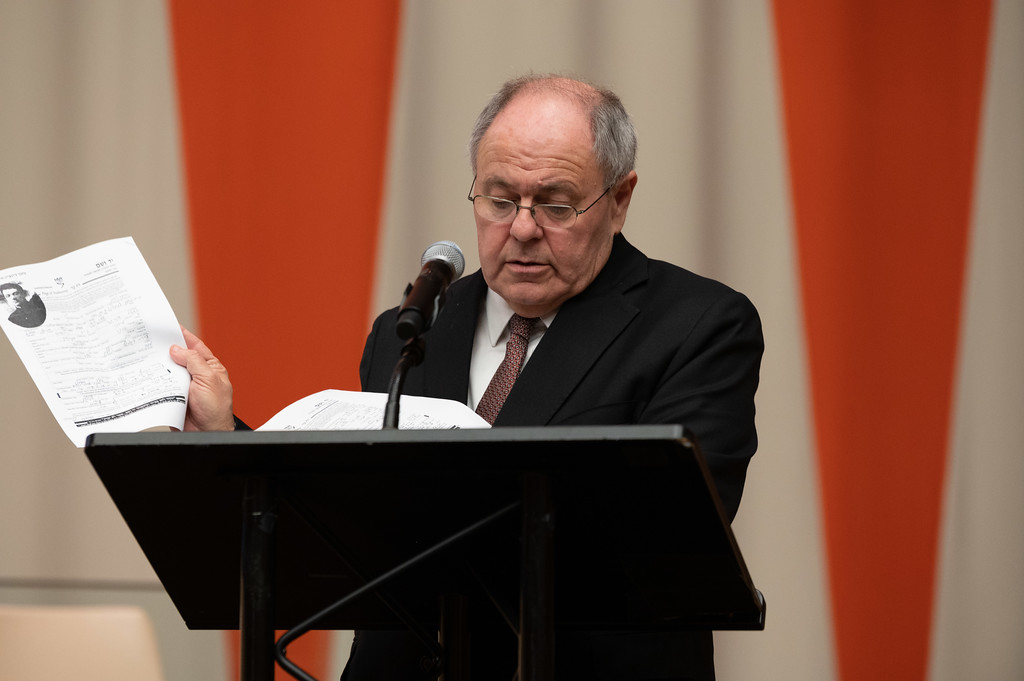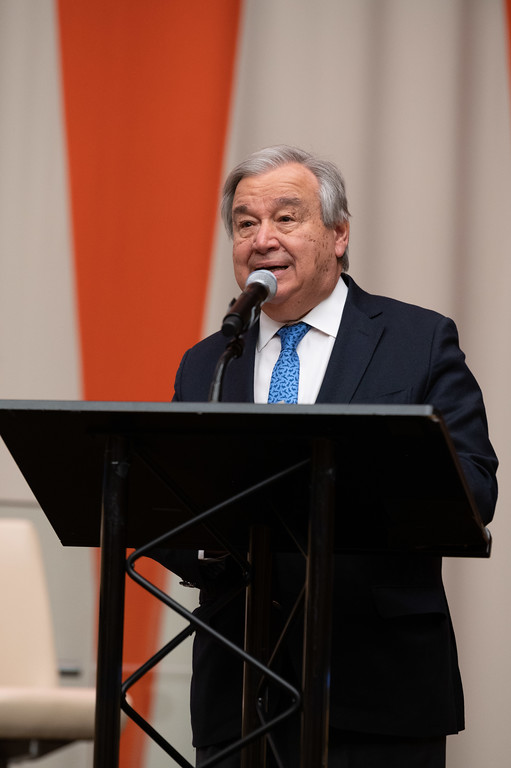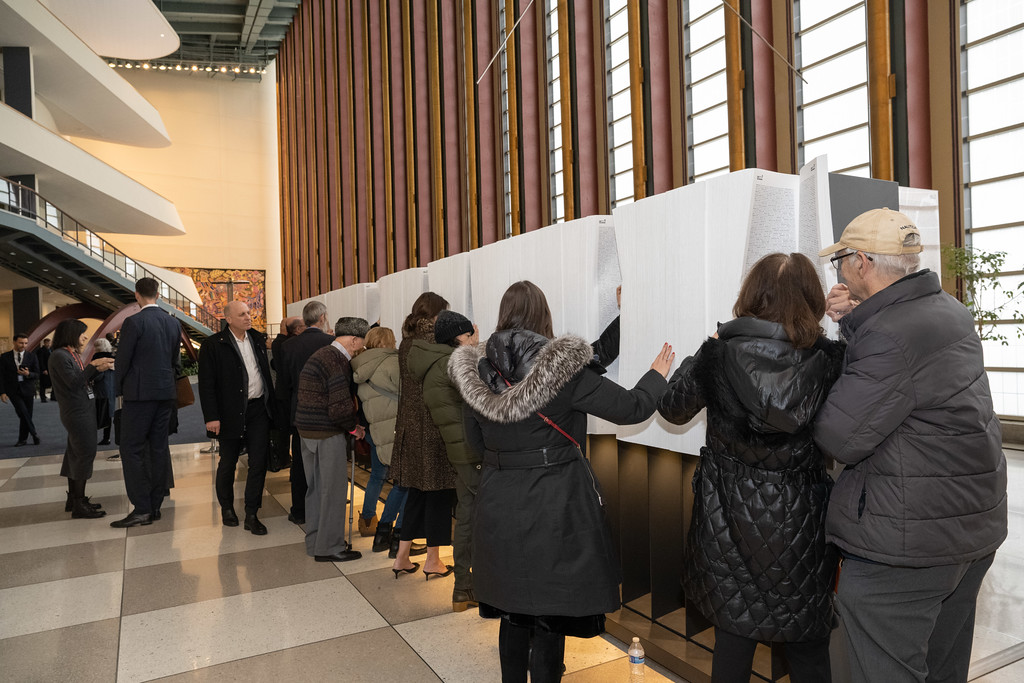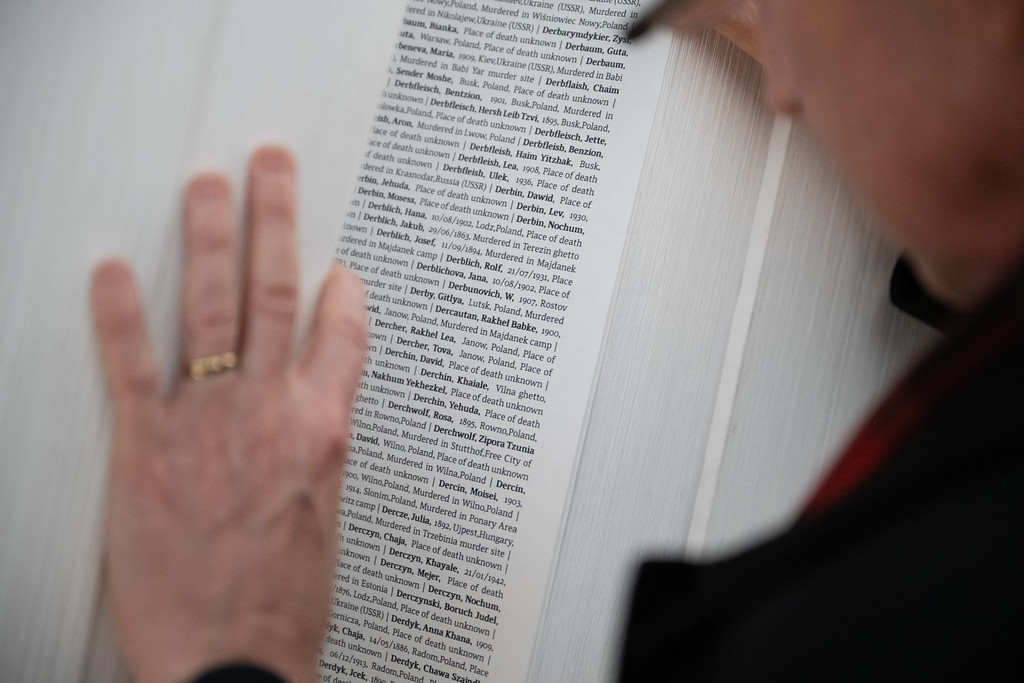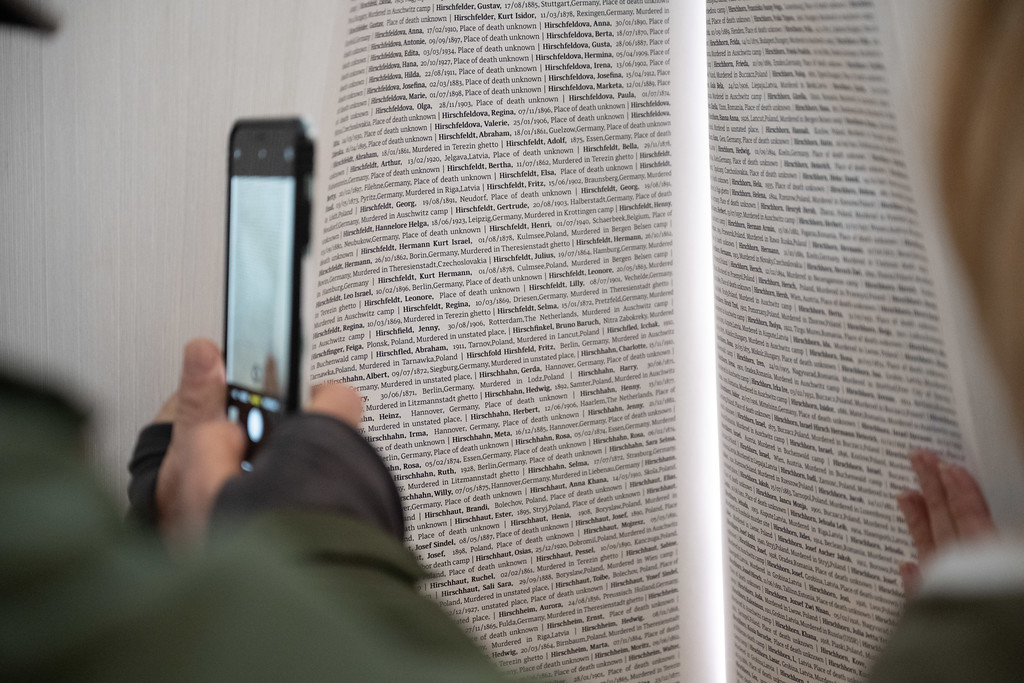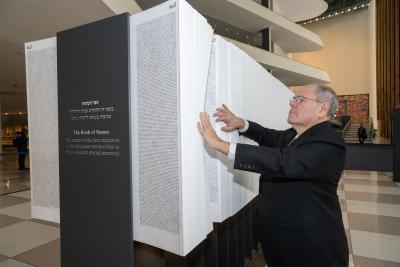
Dani Dayan peruses the Book of Names of Holocaust Victims newly installed at the UN Headquarters in New York City.
For more pictures click here
27 January 2023
On 26 January 2023, Yad Vashem Chairman Dani Dayan and United Nations Secretary General António Guterres unveiled the new "Book of Names of Holocaust Victims" at the UN Headquarters in New York. This exhibition is part of the activities of the United Nations Outreach Programme on the Holocaust for this year's International Day of Commemoration in Memory of the Victims of the Holocaust, marked each year on 27 January – the anniversary of the liberation of the Auschwitz-Birkenau concentration and death camp.
This monumental installation features the alphabetically arranged names of 4,800,000 Holocaust victims currently documented and included in Yad Vashem's Central Database of Shoah Victims' Names. The total length of the Book of Names is 26.45 feet (8 meters). It stands 6.56 feet (2 meters) high, and is 3.3 feet (one meter) wide. A strip of light runs the length of the inside of the Book of Names, illuminating the memory of the Jewish men, women children murdered during the Holocaust for all to remember.
At the end of the Book are blank pages symbolizing more than one million identities yet recovered from the nameless murdered.
Accompanying the installation is a video clip about the importance of remembering the names of Holocaust victims and the rationale behind the Names Recovery Project, as well as an explanatory panel with information about the Holocaust – the anti-Jewish campaign initiated and implemented by Nazi Germany during the years 1933-1945 that culminated in the unprecedented and systematic genocide that aimed to totally eradicate Judaism and annihilate the Jewish people.
The names and other biographical details in the Book are taken from many sources, including Pages of Testimony collected by Yad Vashem, as well as various lists compiled during and following the Shoah, meticulously gathered over the past seven decades and carefully reviewed by Yad Vashem experts. An earlier installation of the Book of Names is on permanent display at Yad Vashem's SHOAH exhibit at Block 27 of the Auschwitz-Birkenau State Museum in Poland.
In his address at the United Nations, Dani Dayan read out the names of his great-uncles, Nahman and Arieh – his grandmother's brothers who were murdered during the Shoah – which he first saw in the Book of Names in Poland. He spoke of "the deeply moving experience" to search for names of lost relatives and friends in the Book, which is now possible "for any person, of any nation, community or faith who seeks to connect with the crucial, deeply significant story of the Holocaust… Tragically we cannot revive even one of the millions that they murdered, but we can, and do, restore their names and stories… we do this because the victims deserve no less."
"History never repeats itself exactly, but the phenomena of extreme antisemitism and other racial hatreds, aggressive violence and corrupt dictatorships are recurring. To combat and overcome them, we can and must learn from the Shoah. And we start that by faithfully and accurately remembering its victims. That is why the Book of Names is here now."
"The six million Jewish men, women and children are lost forever, but their memories and their names will never be forgotten," said UN Secretary General Guterres. " This exhibition is a call to action – some one million victims remain unidentified, and we are racing against time. It is a call to remembrance, as fewer and fewer can be direct witnesses, and we will have to find a way to carry the Torch of Remembrance forward."
"And this exhibition is a call to reflection – to see each child, woman and man who was murdered as a human being with hopes and dreams – not a faceless, nameless victim. It is a call to all of us – not to add to the poison of hate, that hate that says another person is less than my equal, less than human. Together let us stem the tide of human cruelty and fight against all forms of racism, wherever and whenever it manifests itself."
The Book of Names, which was produced with the generous support of Yad Vashem Visionaries Marilyn and Barry Rubenstein from the United States will be on display in the UN Headquarters in New York through 17 February 2023. At the conclusion of its display at the United Nations, the installation will be brought to Israel to be permanently included in Yad Vashem's Museum's Complex on the Mount of Remembrance, and will open to public viewing in time for Israel's Holocaust Remembrance Day, observed this year on 17-18 April 2023.
* * * * * *
Also, on 26 January 2023, Yad Vashem's ready2print exhibition "Shoah: How was it Humanly Possible?" was unveiled in the lobby of the European Parliament in Brussels, in the presence of President of the State of Israel H.E. Mr. Isaac Herzog. President Herzog presented European Parliament President H.E. Ms. Roberta Metsola with a copy of a painting from Yad Vashem's Art Collection. The well-known artwork, entitled "The Refugee," was created by German Jewish artist and Holocaust victim Felix Nussbaum while in hiding in 1939, and reflects Nussbaum’s fear and desperation on the eve of World War II.
That same day in Jerusalem, on the Mount of Remembrance, Yad Vashem hosted its annual symposium for the international diplomatic corps in Israel. The event featured lectures relating to this year's central theme for Holocaust Martyrs and Heroes Remembrance Day (observed on 17-18 April 2023), Jewish Resistance during the Holocaust: Marking 80 Years since the Warsaw Ghetto Uprising. Newly appointed Minister of Education Yoav Kish delivered a keynote address at the symposium. The head of the diplomatic corps in Israel, Zambian Ambassador H.E. Mr. Martin Mwanambala also spoke, and Yad Vashem Chairman Dani Dayan addressed all in attendance via a video greeting.
In the Visitors Center at the entrance to the Yad Vashem campus, a special artifact relating to the liberation of Auschwitz-Birkenau was on display. The item is a carved wooden box with a dedication in Russian, which Holocaust survivor Dr. Arthur Hollander received in recognition of his treatment of wounded prisoners-of-war during World War II. Hollander, who served as a doctor in the Yugoslav army, was captured by the Germans and imprisoned in a POW camp. He treated the wounded prisoners, most of whom were Red Army soldiers who then prepared the box out of gratitude to him.
Online
Yad Vashem created a mini-site marking International Holocaust Remembrance Day, featuring a variety of resources the public can view, share and engage in, including online exhibitions, educational resources and the unique IRemember Wall.
As Yad Vashem’s flagship annual commemorative project, the IRemember Wall allows individuals to be randomly linked to one of the 4,800,000 Jews murdered in the Holocaust currently registered in Yad Vashem's Central Database of Shoah Victims' Names. The participant's name then appears on the IRemember Wall together with the name of the victim of the Holocaust. The user can also choose a specific name of a family member or anyone else from the Names Database with whom they wish to be matched – and then share their stories via their own social media.
In addition, Yad Vashem has launched a new online exhibition for International Holocaust Remembrance Day, entitled "Personal Milestones during the Holocaust." While fighting for their very existence, Jews during the Holocaust also strove to maintain their identity and culture. Marking personal milestones, including weddings and bar/bat mitzvahs, and even the preparation and sending of birthday cards when conditions permitted, helped assuage their emotional turmoil and gave them a sense of routine and stability. The customs that had accompanied the Jewish people for centuries were a source of comfort during the Shoah. They provided perpetually anxious, persecuted men, women and children with a feeling of continuity and optimism, and maintained a precious link in the sacred generational chain between the custodians of venerable traditions.
